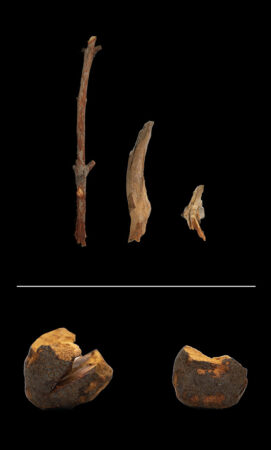This post was originally published on this site
Like teenage Romeos toting sticker-plastered guitar cases, male palm cockatoos show that romancing a crush with a love song isn’t just about music — it’s also about style.
Wild palm cockatoos (Probosciger aterrimus) craft bespoke instruments for musical mating rituals according to their individual tastes, researchers report September 13 in Proceedings of the Royal Society B. Some males were drumstick devotees, others made a mix of drumsticks and seed pod instruments, and one unorthodox male marched to the beat of his own pods — he made almost no drumsticks at all. These individual touches have more to do with personal preference than with available materials, the team found, hinting that these rockin’ cockatoos’ mates might prize creativity or individuality.
Adding distinctive touches to their instruments is not “a routine that is always the same in every animal,” says cognitive biologist Alice Auersperg of the University of Veterinary Medicine Vienna, who was not involved in the research. “There is some element of innovation to it.”
If humans were birds, we might be something like parrots. Like us and our primate cousins, parrots have big, clever brains, complex social lives and extended childhoods spent learning from their parents.
Unlike primates, most parrots aren’t known to use tools in the wild. And “most parrots that have been studied using tools have been studied in captivity,” Auersperg says. For instance, her team found that wild-caught Goffin’s cockatoos (Cacatua goffiniana) held temporarily in a research aviary, wielded sophisticated toolkits for foraging (SN: 2/10/23).
Wild palm cockatoos are a fabulous and fascinating exception. These striking, endangered birds live in parts of northern Australia and New Guinea, and they craft and use tools not to find food, but to find a mate — a rarity that stands out even in primate company.
A male palm cockatoo puts on a musical mating display from trees in his territory. He sings, twirls and drums rhythmically against the tree, often using a percussion instrument, a stick or seed pod, clutched in his left foot (SN: 6/28/17). As part of the display, he crafts the instrument himself and the female watches as he snaps off tree branches and whittles them just so. Add in the birds’ dramatic black and red plumage and tall, spiked crests and you’ve got perhaps the closest nature can come to a rock concert.

“Those tapping displays actually have all the hallmarks of human music using instruments,” says conservation biologist Rob Heinsohn of the Australian National University in Canberra. “And the males all have their own drumming signatures. Some like to do it really slowly, some go very quickly, and then others throw in little flourishes.”
Heinsohn and his colleagues wanted to see if these rocker birds express their singular style through their instruments, too.
Over two years, the researchers wandered Australia’s Kutini-Payamu National Park and surrounding Aboriginal lands listening for the calls of displaying male cockatoos. This led the team to 70 display trees, where the scientists collected a total of 227 drumsticks and 29 seed pod instruments discarded by the birds. Like a musician smashing a guitar at the end of a concert, male cockatoos toss their instruments to the ground after a display.
Comparing instruments discarded by 12 individual cockatoos revealed what the researchers interpret as evidence for individual preference in their instrument designs. Drumstick length varied more from bird to bird than would be expected by random chance. Some preferred short and stubby drumsticks, while others made longer, thinner ones.
“Each one has developed his own idea as to what makes a special drumstick,” says Heinsohn. There are many “different ways of getting it right — of being a good artist, both in their musical performance, but also in the crafting of these tools,” he says. “I think being really individual and being creative and being out there on your own is part of what the females are looking for.”
While musical instruments are practically universal across human cultures, and we frequently incorporate flashy objects into our romance rituals, other animals rarely use tools for either music or mating displays. Scientists also rarely find evidence for individual creative choices among nonhuman toolmakers.
This makes palm cockatoos triply fascinating: With their signature styles in music and craftsmanship, these feathered flirts are a good reminder that humanity isn’t always as special as it seems.
